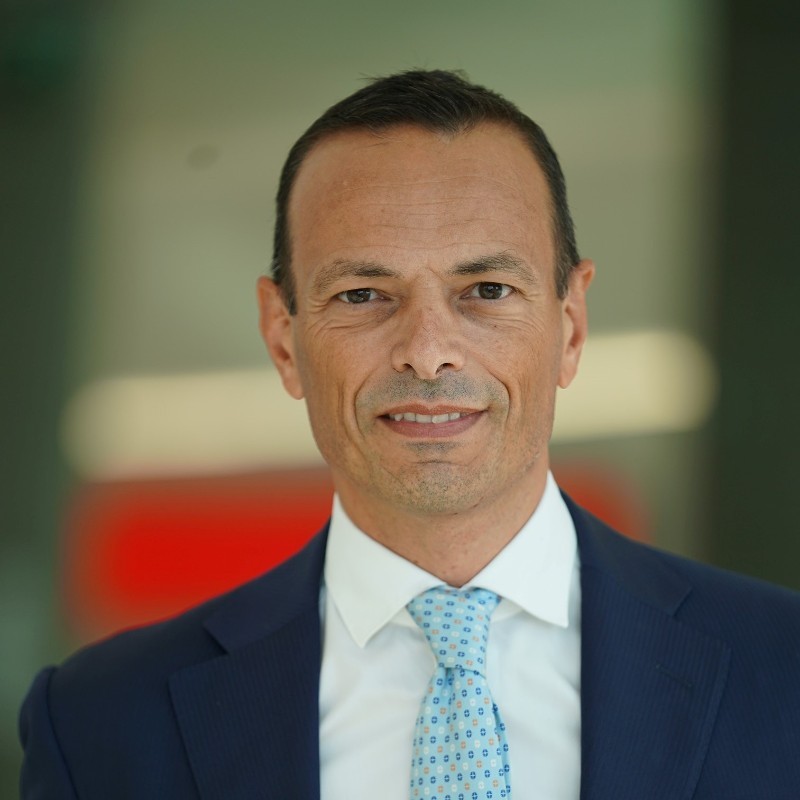Key Investment Themes 2024

In Short
INTRODUCTION
The global economy showed remarkable resilience in 2023, avoiding the sharp recession that was widely expected at the start of the year. A continually shifting macro environment led to heightened volatility across asset classes. Inflation decelerated and a ‘higher for longer’ narrative around interest rates set in, with positive real yields returning capital competition to markets.
Will 2024 see central banks cut rates?
How can investors position for an uncertain growth outlook?
And is AI optimism a passing trend?
To answer these questions and more, we are pleased to present the latest views from the specialist asset management firms across the Generali Investments ecosystem, as they look ahead to the risks and opportunities that 2024 may present.
Macro Overview
Fixed Income
Equity
Multi Asset
Liquid Alternatives
Private Debt
Real Estate
Infrastructure
ESG
THE BIG PICTURE
The Market and Macro Research team at Generali Asset Management introduce the key themes they’re monitoring for 2024.
Beware the consensus! Investors started 2023 with too much pessimism. There seems to be a greater variety of views for 2024, but lower inflation and yields, key rates cuts and curve steepening, a pullback of the USD and a mild equity melt-up generally seem to be expected (Goldilocks).
1. Macro: Before the dawn
After striking resilience in 2023, the global economy is set to slow in early 2024. The euro area is already flirting with a mild recession; persistent scars from the energy shock and a looming fiscal tightening keep the outlook flattish. The US will (finally) feel stronger headwinds as high interest rates bite while the support from excess savings and fiscal profligacy fade. A tepid Chinese recovery will not provide broader relief. Yet we expect the global outlook to stabilise by mid-year on the back of a bottoming global inventory cycle, and somewhat resilient labour markets and real incomes. Fading headwinds from monetary policy may help growth to gain some traction later in the year.
2. Preparing for the pivot
As evidence of easing price pressures mounts, major central banks have reached peak rates. Yet these are likely to prove an extended plateau well into 2024. Core inflation rates are unlikely to fall below 3% before mid-2024. Central banks will be wary of declaring premature victory on inflation. Should investors front run the turn, anyway? Alarmingly, the related easing of financial conditions would only delay those policy rate cuts. This creates a self-correcting mechanism that may finally depress rates volatility in 1H24. We expect the first rate cuts in the US and euro area not before June. The BoJ will buck the global easing trend with a first rate hike, likely in H2.
3. Geopolitics: The known unknown
From the invasion of Iraq in 2003 to early 2022, the world enjoyed c. 20 years of remarkable stability. No more. The war on Ukraine and the terrorist attack on Israel may have marked the beginning of a more volatile era, as the world transitions to a new, multipolar order. Among the 2024 risks, OPEC+ could ration oil production further to push prices up, further eroding support to mainstream parties and climate policies into key European (June) and US (November) elections. China/US tensions may rise amid the US election campaign and escalate further on a Trump victory. On the bright side, incumbents may veer towards global stability and de-escalation. Any diplomatic break-through in Ukraine would be a positive surprise for European markets.
4. Structural trends coming to the fore
Structural changes, such as demographics, impact financial trends only slowly, yet several forces are coming to the fore.
Climate change has accelerated (record temperature anomalies). Expect, among others, a growing burden on public finances, an adverse impact on the growth-inflation mix and new challenges for insurers. Elections are a threat to battered renewable energy stocks, but lower interest rates should help.
Deglobalisation may be exaggerated, but friend-shoring and de-risking are happening. Europe’s eroded competitiveness remains a concern.
AI is coming to the rescue of poor productivity trends, but this will kick in only gradually over the next years.
The rise in real yields, along with weak real GDP growth, makes a poor cocktail for sovereign debt sustainability. Climate and military spending needs add insult to injury: a fatter tail risk for the EA, given the missing fiscal union.
In all, we agree that bond yields will end 2024 below current forwards but expect the downside to be limited (especially in 1H24) given supply considerations, investor positioning, slow disinflation and selected central bank trends (QT, BoJ turn). We see little value in front-running rate cuts and aggressively re-weighting risk assets (equities, high yield, cyclicals etc.) early, given the current Goldilocks pricing, the economic risks, and "central banks" reluctance to see financial conditions ease too quickly. On the bright side, rates volatility is set to fall sharply from still elevated levels, and we expect investment grade to benefit from both fundamental and technical conditions. Highly leveraged sectors remain exposed to a delayed reaction to massive 2022-23 rates hikes. Geopolitics are a wild card but risks there are two-sided.



EUROPEAN GOVERNMENT BOND AND CREDIT
Duration and IG European credit can optimise returns in 2024
"The receding tide of inflation is a welcome development"
Mauro Valle, Head of Active Fixed Income
With inflation expected to continue its downward trend and central banks potentially pivoting to a more accommodative stance, we believe the environment is ripe for European government bonds to thrive in 2024.
The receding tide of inflation is a welcome development. As price pressures moderate, central banks should begin to ease their tightening bias, potentially leading to rate cuts around mid-2024. While the rhetoric in the coming weeks may remain cautious, emphasizing the need to keep inflation expectations anchored, the underlying trend suggests a shift towards a more dovish policy stance.
Eurozone rates, after the downward movement observed in the last few weeks, are likely to remain range-bound for a few more months, pending further confirmation of the macroeconomic scenario. With growth likely at its weakest stage, a recovery is expected in the second half of 2024 which should benefit European credit.
The current inversion of the Eurozone yield curve reflects market expectations for future rate cuts. When the central bank does signal its intention to ease policy, the yield curve should steepen, with the 2-10 year Eurozone spread widening and a likely outperformance of medium-short maturity bonds.
Given the favourable outlook, we think investors should exploit current elevated interest rates to optimise returns. We continue to consider Italian BTPs as a good way to maximize returns in 2024, aiming for yields of around 4%. At the same time, adding duration would be a useful diversification strategy in the event of a risk-off environment or increased volatility.
In terms of European corporate bonds, there are good opportunities to accumulate carry and excess returns purely with high quality, well-rated instruments, particularly from robust financials and industrial conglomerates with businesses less correlated to the economic cycle. We believe 1-5 years maturities offer the best risk-return reward, but along the course of the year it may be wise to lengthen spread duration, to remain in safe territory. The risks to this proposition are the higher cost of debt or unexpected distress situations of companies that cannot easily refinance their debt through the usual borrowing channels.


LDI FIXED INCOME SOLUTIONS
Constructive on rates and solid investment grade issuers
"We continue to expect a bull steepening of sovereign curves"
Sebastiano Chiodino, Head of Liability Driven Investment
Financial markets are closing the year on a generally dovish tilt, with rates futures already pricing in a first full cut from the ECB and the Federal Reserve as early as April and May 2024 respectively. We think this expectation is somewhat overdone and prefer to stay tactically cautious considering the startling European government bond issuance in the first half of the year. In the medium term we see the risks more tilted toward lower rates in a deteriorating macro backdrop that does not lead to a hard recession. In the absence of an economic crash on the horizon, we continue to expect a bull steepening of sovereign curves, with sovereign spreads hovering around current levels. On the one hand, Italian BTP yields should benefit from a reduction in risk-free rates but, on the other hand, the large Italian issuance will likely have a negative impact.
In credit, we are closing the year with very positive total returns across the board, thanks to a combination of marginally tighter spreads, carry, and lower rates.
We are generally constructive on 2024, particularly for investment grade, the safest part of the credit market, where the fundamental deterioration should be manageable. Our view is based on macro conditions (lower rates driven by central banks cuts and a benign soft landing) and supportive technicals; supply should be well-absorbed and flows into the asset class should be net positive, especially in Q1 with investors happy to put more cash to work.
Sector selection will be important. We particularly like utilities and other areas of the market that are positively correlated to rates. We also like banks and financials in general, which with solid balance-sheets and still attractive valuations should navigate 2024 without any capital hits.
Nevertheless, tail risks are still present (recession/hard landing, high inflation prints) especially for the riskiest credit buckets. We therefore suggest a more cautious approach to speculative-grade issuers, with a big question mark over the refinancing needs of those companies highly exposed to cyclical dynamics, where the cost of debt will spike several percentage points higher. In essence, we are aiming to stay constructive but safe on solid investment grade issuers.


GLOBAL UNCONSTRAINED FIXED INCOME
Exploring the globe for mispriced opportunities
"We favour crossover credit, which straddles investment grade and high yield"
Mauro Ratto, Co-Founder and Co-Chief Investment Officer
The normalization of interest rates and more resilient inflation than expected has made investing in bonds more competitive than equities for the first time in 15 years. As we approach the end of the rate cycle, refinancing risk is a looming concern, particularly in the face of increased issuance and maturing debts. Diligent credit research and the freedom to invest across the fixed income universe is key, selecting sectors and bonds that offer resilience in a changing economic landscape.
In terms of duration, we favour the short-end of the curve, with a focus on 3-5 year spread duration due to the potential for spread widening in the tightest parts of the credit market. We’re focusing on optimising risk-return by finding mispriced opportunities in high quality credit from issuers with strong fundamentals and low leverage.
In terms of sectors and themes, we see diverse opportunities across corporate credit, from recovering industries to mispriced securities and sectors. Oil & gas is a particularly robust sector characterized by strong cash flows and solid balance sheets. Hybrid oil & gas instruments offer much higher yields than senior debt and are typically callable at the first call date.
European corporate debt continues be a rich source of issuers with high creditworthiness and quality balance sheets with moderate leverage. We favour crossover credit, which straddles investment grade and high yield. We invest along the capital structure, selectively buying subordinated debt of investment grade issuers, particularly in the telecommunications and energy sectors, which exhibit strong cash generation profiles.
Sectors facing challenges offer a host of mispriced opportunities for investors able to perform robust credit analysis. The recovering airline sector, for example, offers outsized yields, with senior secured collateralized paper backed by assets worth several times the issued debt. Several airlines have restructured their debt and improved their balance sheets, with some European issuers moving closer to investment grade status.
Real estate has also faced challenges, particularly in the office space segment; nonetheless, logistics has emerged as a resilient subsector. Insurance is another sector where there are strong European insurance issuers that offer investment grade instruments with higher yields than expected, due to their association with a weakening sector.


SUSTAINABLE FIXED INCOME
Opportunities abound in less efficient responsible credit markets
"ESG integration remains less advanced in credit analysis which means that markets are potentially less efficient"
Stanislas de Bailliencourt, Head of Fixed Income and Asset Allocation
Fixed income markets made their comeback in 2023 as real interest rates are finally back in positive territory, implying that investors can earn returns higher than the fall in their purchasing power due to inflation. This comes at a time when corporate fundamentals remain surprisingly resilient in a context of high inflation. We therefore expect default rates to remain relatively low. Credit markets, especially investment grade bonds, offer attractive yields while credit spreads provide an attractive risk-return trade-off. Interest rates are set to stay ‘higher for longer’ and we are comfortable with the idea to take on slightly more interest rate risk by increasing the duration of our portfolios. This will be accompanied by reducing credit risk and shifting our attention towards investment grade bonds (mainly BBB).
In addition, we are witnessing an increase in Sustainability Linked Bonds (SLBs) issuance showing that the ESG commitment of corporates is improving. However, this trend is associated to potential ‘greenwashing’ which must be detected through a rigorous sustainability analysis. While ESG integration is popular amongst equity investors, it remains less advanced in credit analysis which means that markets are potentially less efficient and offer additional return opportunities that can be exploited. For 2024, we see appealing valuations for companies providing eco solutions as these will profit from public support measures rolled out by the Net Zero Industry Act in the EU or the Inflation Reduction Act in the US. Industry sectors like utilities or industrials are likely to benefit from this support.
On the other hand, sectors with high refinancing needs in the coming years, such as real estate, might remain under pressure.
Overall, fixed income markets have not been as attractive for more than a decade and we believe that demand for this asset class will continue to increase throughout 2024.


LONG-SHORT GLOBAL CORPORATE CREDIT
Looming bifurcations may present a rich source of long-short credit opportunities
"Cracks in the market typically manifest 18-24 months after the first rate hike"
Simon Thorp, CIO Fixed Income Aperture
Recent months have seen a notable fall in inflation in many parts of the world, combined with some easing of labour shortages. Markets now expect a decline in US rates around the middle of 2024. If this narrative proves to be correct and if growth doesn't fall off a cliff, we anticipate a ‘Goldilocks’ scenario where conditions align for a corporate credit market sweet spot.
The nuance here is that any more severe fall in inflation or rise in unemployment will, in our view, quickly tip market sentiment to the recession end of the spectrum, with a subsequent sell-off in risk assets.
While a myriad of uncertainties remain for credit markets, there is healthy level of spread dispersion. The substantial maturity wall in the high yield and leveraged loan sectors, spanning from 2024 to 2026 is likely to increase that dispersion. The cost of capital has escalated to levels that could pose challenges, particularly for businesses with weaker credit metrics. We're likely to see a bifurcation in terms of the issuers that the market is prepared to refinance or not, which would offer up a rich source of long and short credit opportunities in 2024.
As the landscape evolves, certain sectors are poised to experience shifts. Pro-cyclical sectors such as chemicals, building materials, retail, and autos are likely to face challenges. Conversely, sectors that have historically been defensive during bear markets, including financials, energy, technology, media, telecommunications, gaming, and healthcare, have the potential to provide positively convex alpha opportunities.
Should macro conditions deteriorate, potentially impacting company revenues, liquidity could both dry up and become highly selective. Default rates are already on the rise, notably in the US (approaching 5% compared with less than 2% observed in 2022). Credit spreads are only beginning to factor in this evolving dynamic. Cracks in the market typically manifest 18-24 months after the first rate hike, offering investors a valuable timeframe to monitor and adjust their strategies accordingly.
With central banks perhaps incapable of rescuing markets with further stimulus (given current sovereign debt-GDP levels are already too high), the headwinds expected in 2023 are likely to manifest in 2024. In an increasingly unpredictable world, we consider that investors can benefit from flexible strategies that can move quickly as events unfold.


EMERGING MARKET DEBT
Light at the end of the tunnel for Emerging Market Debt
"Some EMs are also benefiting from the ‘friendshoring’ or diversification away from China"
Peter Marber, CIO Emerging Markets
We are cautiously optimistic for 2024. The US looks close to ending its hiking cycle as its economy cools. Typically, market turnarounds precede rate cuts, and recent months have shown a turn in market sentiments. A late 2023 risk rally helped propel most EM hard currency indices to potentially finish the year in positive territory approximately 4% ahead of the US aggregate bond index.
For 2024, the prospect of synchronized cuts across various EM countries could present ample opportunities across all EM asset classes including credit, local rates, and FX. Some EMs are also benefiting from the ‘friendshoring’ or diversification away from China, which could also spur positive momentum in some countries. Mexico, for example, attracted more than $50 billion in foreign direct investment (FDI) in 2023 (its highest levels in several years). India is also attracting more FDI and it is expected to grow by more than 6.3% in 2024 according to the IMF, its fastest level in several years. At this stage, any normalisation of, or improved, trade relations between the US and China, also could inject optimism and fuel growth in EMs further. The recent meetings between President Biden and Chairman Xi might even give a boost to world trade which has slowed in the last decade.
A weaker US dollar in 2024 would, we believe, generally lead to stronger EM currencies and more relaxed financial conditions, which could allow companies to borrow at lower rates and may initiate a virtuous cycle of growth. The primary markets for EMs effectively have been shut for two years, and falling interest rates could spur some new borrowing which would be beneficial for most high-yield countries, particularly lower GDP Frontier Markets. EM US dollar yields for investors are in our view particularly attractive in the high yield space. At current spreads of 750 bps above US Treasury yields, investors are being compensated more than 125 bps above trailing 10-year averages. There are also more US dollar bonds trading below par and at distressed levels (below 70 cents), providing in our assessment additional opportunities for trading gains in 2024, including some linked to sovereign and corporate debt restructurings.
It has been a tough decade for EM assets, with the last two years being among the most difficult and volatile in 21st century. It appears that the worst is behind us, hopefully ushering a new period of above-market returns from Africa, Asia, the Middle East, Latin America, and Eastern Europe.



SUSTAINABLE THEMATIC EQUITIES
Tech as a dominant theme
"The coming wave of investments in AI could be the most impactful mega trend for the technology sector"
David Rainville, Portfolio Manager, Global Technology
Demand fundamentals in the tech sector remain relatively resilient despite the significant change in the interest rates environment. This strength surprised most investors, and that combined with better entry points in 2022 fuelled a strong rally in the first half of 2023. Further catalysing this rally was the mass-popularization of ChatGPT, which unlocked significant investments from businesses into generative AI. We believe that the coming wave of investments in AI could be the most impactful mega trend for the technology sector.
To even hope for an AI-driven future, we believe the world’s digital infrastructure and cybersecurity needs will have to go through significant modernization to handle and process the amount of data and computing processing power that this mega trend will create. The magnitude of investment needed is unprecedented, impacting companies like Nvidia’s revenue expectations by more than $45bn for next year (from ~$36bn to now ~$81bn).
In 2024, we expect that “deep tech”, modern digital infrastructure, and cybersecurity companies will benefit greatly from this modernization. Not only do we believe this has already started in 2023, but we see this as a multi-year, trillion-dollar-plus wave of investments from which savvy technology investors can make money on. Outside of those AI specific investments, technology spend trends are starting to turn back around following a difficult 18 months of normalization and rationalization in IT budgets following the strong movement of IT spending during the pandemic. This is evident over the last few months with server shipments troughing, PC spending recovering, memory chip pricing improving, and software bookings stabilizing.
As long-term sustainable investors we favour companies that will benefit from medium-term, long-term and mega trends that also offer technological solutions with a positive impact on our world, either through an environmental or social lens. For example, medtech and edtech are themes that will have a positive impact on our society by improving education and health outcomes. More generally, we believe companies that incorporate sustainable technology in their business models are likely to benefit even more from these trends themselves as well. We look for companies that seek to reduce negative externalities as those can drive unforeseen costs and risks that can significantly impact forward equity returns.


HIGH CONVINCTION EUROPEAN EQUITIES
Gen AI, life longevity software, and defined EVs poised for growth
"Europe, as a manufacturing continent, offers many hidden gems terms of benefiting from AI innovation"
Anis Lalhou, CIO Equity at Aperture
We believe Artificial intelligence (AI) is poised to continue its rapid growth trajectory in 2024, driven by increasing adoption across various industries and technology.
Generative AI, which utilizes neural networks to create new content, such as images, text, and music, is expected to make significant strides in 2024. This technology holds immense potential for applications in marketing, design, and entertainment.
Meanwhile, the pursuit of extending human lifespan through AI-powered interventions is gaining traction. Research into ageing and longevity is expected to advance in 2024, potentially leading to breakthroughs in healthcare and pharmaceuticals. Longevity software, meaning AI-driven software tools that help individuals track and manage their health data, providing personalized recommendations for diet, exercise, and lifestyle modifications, are anticipated to gain wider adoption in 2024.
Finally, the concept of defined EVs, where the battery is separate from the vehicle itself, is gaining attention as a potential solution to address ‘range anxiety’ (the fear that an EV will not have enough battery charge to reach its destination, leaving occupants stranded) and improve EV affordability. We think this technology could see significant advancements in 2024.
On a more granular basis, manufacturers of graphics processing units (GPUs), essential for training AI models, are expected to continue their growth trajectory as AI adoption accelerates. Producers of cloud services should also benefit from the increasing demand for cloud-based AI solutions. Companies that are placing significant investments in AI research and development, particularly in areas like natural language processing and machine learning, should be well-positioned to capitalize on AI-driven innovation. Finally, we believe that Europe, as a manufacturing continent, offers many hidden gems across various sectors in terms of benefiting from AI innovation.
While in our view AI presents compelling investment prospects, there will be losers as well as winners given the speed at which the technology is still evolving. Regulation is still catching up, and could impact adoption and deployment, while the potential societal impacts of AI, such as job displacement and privacy concerns, need to be carefully evaluated to ensure responsible investing practices. While careful consideration of the associated risks is essential, we believe AI's long-term growth trajectory makes it a critical investment prospect for 2024 and beyond.


EQUITY SOLUTIONS
Chase the yield in Europe, explore AI in the US, and monitor margins
"Most corporates are still significantly over-earning in net margins terms compared to pre-Covid levels"
Luca Finà, Head of Active Equity at Generali Asset Management
In 2024 we expect Europe to be the geography with the highest cash distribution to shareholders taking into account both dividends and buybacks. Dividends are expected to grow by around 6.5%, almost in line with earnings, while buybacks should remain at an all-time high of around 2%, thanks to strong balance sheets, high free cash flow yields and low valuations, giving an overall yield of over 5.6%. In the period post Covid, the percentage of companies and sectors buying their ’own shares’ increased meaningfully bringing buybacks to above one third of the total cashflow distribution, a cash deployment welcomed by investors. Although banks and energy are still leading the group for expected buybacks in 2024, corporates belonging to more defensive sectors like telecom and consumer staples will also represent a portion of the total.
We also expect a continuation of artificial intelligence as a long term theme in 2024. Although the performance of AI-related stocks was impressive in 2023 and valuations are not cheap in an historical and relative context, earnings growth is poised to be consistently higher than the rest of the market in the years to come, with potentially less sensitivity to the macroeconomic cycle. Our expectation is that in the following months and years we will witness an acceleration in AI innovation and adoption as multiple technologies emerge at the same time. Furthermore, we expect to find opportunities not only in the tech sector but also within knowledge-intensive service sectors and manufacturing companies that can improve efficiency through the adoption of AI.
Finally, after approximately one year and a half of negative operating leverage, Q3 2023 proved to be resilient on margins, and investors and analysts are expecting either an improvement or at least stability in 2024, depending on different geographies. On an aggregate level, most corporates are still significantly over-earning in net margins terms compared to pre-Covid levels. As fading inflation and weakening consumer demand could limit the ability to pass price increases to customers, it will be important to focus on sectors and above all on companies with solid business models, high pricing power and cost flexibility to better defend current high profitability.



GLOBAL MULTI-ASSET
The return of decorrelation
"We think growth should decelerate in 2024, shifting correlations between assets"
Cedric Baron, Head of Multi Asset Strategies at Generali Asset Management
Next year is likely to be a turning point that will require a new investment playbook. For multi-asset investors, one crucial element may be back in favour: decorrelation between asset classes, the basis for the sacrosanct rule of diversification.
Extreme jumps in inflation have turned equity and bond correlations in positive territory, while a return to more ‘normal’ levels of inflation should refocus investors on economic growth to determine price equilibrium. If growth is weak and inflation sufficiently low, then growth will again be the main concern for investors and equity and bond decorrelation will return to the fore. Indeed, as we expect high interest rates and tight financial conditions to eventually hurt consumers when refinancing needs arise, we think growth should decelerate in 2024, shifting correlations between assets.
In addition, we believe that much higher yields will be positive for multi-asset strategies, which have benefited from high carry this year and which we expect to continue into 2024. We also expect these strategies to benefit from price rises in the fixed income segment.
The equity market's reaction will depend on the resilience of economic growth. If inflation slows while economic activity is low but positive, we will return to a Goldilocks scenario, which is positive for equities. But if the slowdown is deeper than the soft landing currently priced in, equities could fall despite lower interest rates. This illustrates how uncertain 2024 could be, as it will depend on hard-to-predict price and activity data.
We therefore believe that multi-asset strategies can play an important role for investors in this environment. Uncertainties are high and the economic scenario can change drastically depending on macro variables (from prices to activity). A passive allocation is therefore unlikely to meet the need to adapt to very different scenarios. Reactive and flexible allocation will be key. Multi-asset strategies can also add significant value through their ability to use sophisticated financial instruments to better adapt to market changes across a very broad range of asset classes. The use of optionality will help provide flexibility, while sources of carry have the potential to be multiplied through different asset classes such as fixed income volatility, commodities and equity dividends.


GLOBAL UNCONSTRAINED MULTI-STRATEGY
Why the energy transition opportunity needs a multi-strategy approach
"The move towards a value-driven approach will emphasize dividends, cash flow generation, and reasonable valuations"
Mauro Ratto, Co-Founder and Co-Chief Investment Officer
The investment landscape is at a crossroads, with central banks signalling higher rates for longer and the return of inflation. The return of capital competition is reshaping the equity allocation assumptions of the past decade, favouring companies that generate cash flow for dividends over those relying on share buybacks.
This new paradigm is why we implement our investment ideas using a five-strategy approach, rather traditional top-down asset allocation. This lens aims to find idiosyncratic opportunities that may deliver specific total return performance outcomes; we call this multi-strategy approach ‘the new active’.
As we move to a new investment era that is defined by higher rates and inflation, deglobalisation, and decarbonisation, we believe that focusing on growth subsidized by public expenditure or generated organically will become paramount. The move towards a value-driven approach will emphasize dividends, cash flow generation, and reasonable valuations. In a world where interest rates are higher, a market trading at 30x earnings, for example, demands a re-evaluation of multiples against a higher hurdle rate.
The energy transition megatrend in particular stands out to us, where companies that can offer sustained growth subsidized by global efforts toward climate-related goals should benefit. Energy is a puzzle that must be addressed in a number of different ways, requiring a diversified approach. Raw materials in particular are key. While a general economic slowdown may impact traditional industrial cycle commodities, those crucial to electrification processes, like copper and uranium, should remain strong. On a longer term view, they also have further upside potential if nuclear energy begins to become a more accepted part of the solution to decarbonisation.
We are also constructive on emerging markets which are benefiting from a normalization of global growth trends. However, with diligent analysis of economic stability and growth prospects is essential; India continues to see rapid growth for example, while China’s growth is starting to normalise. Southeast Asia and Latin America are particularly interesting to us given their exposure to commodities, which as mentioned are key to the energy transition theme.
As the world grapples with the complexities of shifting geopolitical and economic dynamics, we believe a multi-strategy approach that embraces the intertwined challenges we face will be crucial for harnessing returns while mitigating risk.



LIQUID ALTERNATIVES UCITS STRATEGIES
Strong tailwinds for diversified multi-strategy hedge fund returns in 2024
"Diversified multi strategy funds provide an attractive all-weather approach"
Alexander Schoenfeldt, Head of Investments
The inexorable resurgence in interest rates that began in 2022 has caused investors in alternatives to re-evaluate their portfolios, in light of the new “risk free” cash rate against which all investments are benchmarked. In a regime where the ECB's main refinancing rate is currently 4.5%, investors are demanding a return on their investments that commands a premium over cash, but they are also looking for a safe haven from the volatility they experienced in 2022 from a traditional 60/40 equity and bond portfolio.
The good news is that alternative assets have proven to attractive diversification benefits to a conventional 60/40 portfolio, as well as providing a premium return over cash. In fact, a number of hedge fund strategies take a largely hedged or market neutral approach, effectively provide investors with an “alpha” return above prevailing cash rates, so forward-looking return expectations have actually increased as cash rates have risen. Market expectations in the US and Europe now suggest that the bulk of the central bank tightening is behind us. As this dominant macro influence on markets fades, it should provide an attractive opportunity for active managers to generate alpha, as fundamentals reassert themselves as the main driver of returns going forward. This should provide a strong tailwind for hedge fund return generation in 2024 and beyond.
The challenge for many investors is how to access the most attractive funds and how to best blend them in the optimal way to maximise the return and diversification benefits to their portfolios. Alternative assets encompasses a wide range of complex and sophisticated underlying strategies that have their own idiosyncratic cycles and periods of outperformance and underperformance.
At Lumyna, we partner with best-in-breed alternative managers who have demonstrated a consistent advantage in generating returns across multiple cycles and conditions. We believe that diversified multi-strategy funds are particularly well suited to the current environment, as they offer inherent diversification across multiple different sources of return and the ability to dynamically allocate capital to the most attractive underlying strategies at any given time.
This ability to shift capital as opportunities change is an additional source of alpha, over and above the return of the strategies themselves. It also means that capital allocation is delegated to “on the ground” experts who are closest to the underlying markets and who are able to shift capital without the frictional costs and time required for an investor to redeem and reallocate between individual funds. Diversified multi-strategy funds also have an incentivised to maximise the total return provided to investors and do not have the embedded incentive fee “netting risk” that investors face when allocating to multiple underlying funds.
Finally, these multi-strategy funds also benefit from being able to manage their portfolios holistically, as they benefit from full underlying transparency and real-time data and monitoring of all of their positions, which is almost impossible for an investor to do when investing in multiple alternative funds themselves.
In summary, diversified multi-strategy funds offer an attractive all-weather approach to investing in alternative assets, which should result in superior risk adjusted returns that are uncorrelated to existing 60/40 portfolios and other hedge funds.



SUSTAINABLE EUROPEAN PRIVATE DEBT
A golden opportunity for European private debt
"Higher yields, lower leverage and reduced competition present a unique funding opportunity"
Sandrine Richard, Head of Direct Private Debt
Increased investor interest, coupled with the inherent illiquidity premium and lower volatility, makes private debt an increasingly valuable asset class going into 2024. The evolving dynamics in the European SME sector in particular, driven by lower financing from banks, present a unique opportunity for private debt to fill the funding gap. Meanwhile, fundraising changes, economic uncertainties, energy transition and AI integration will be key drivers of challenges and opportunities in the year ahead.
First, fundraising shifts combined with rising debt costs are playing a central role in shaping deal dynamics and acquisition strategies, with a decline in available capital or ‘dry powder’ affecting both private equity and private debt. Private equity firms facing capital constraints are cautious about lowering asset prices, resulting in a temporary period where purchase prices are not yet in line with new buyers' expectations. In response to the difficult fundraising environment, private equity firms are exploring alternative strategies, including paying dividends to investors, while waiting for new funds.
However, this funding challenge is not all bad news and in fact creates a wealth of opportunities for smaller private debt strategies. The reduced availability of capital is leading to a growing trend for private funds to seek smaller ticket sizes and to share opportunities with other funds, resulting in the increased prevalence of unitranche financings, where multiple lenders work together to provide comprehensive financing to SMEs.
The uncertain macro environment can also provide opportunities for strong companies to grow further, for example by acquiring competitors at a lower price. And while inflation and rising energy prices are undoubtedly weighing on corporate profitability, there are positive aspects for private debt. Many companies are reducing leverage to absorb higher financing costs, minimising the risk of default and benefiting more conservative investors. For investors seeking higher yields with reduced leverage risk, floating rate debt is particularly attractive through 2024, as it can mitigate duration risk and portfolio volatility in a period of higher euro interest rates.
In terms of investment selection, the energy transition is critical and affects almost all businesses. We focus on those companies that can contribute to or benefit from this transformational change, either as customers, suppliers or producers, or as part of the financial ecosystem.
The increasing integration of AI into businesses is another fast-growing theme. Companies that can harness this technological leap will benefit from faster processes and decision-making. However, robust due diligence with ESG at its core is essential to determine which companies are able to integrate AI not only successfully but also responsibly, especially in the financial sector.
Finally, we continue to believe that Europe, with its rich tapestry of economic drivers and specialised industry segments in each country, represents a unique growth market and an unparalleled opportunity for both portfolio diversification and selectivity.
In short, higher yields, lower leverage and reduced competition present a unique funding opportunity. We believe that alternative asset players, particularly in the private debt space, are poised to play a transformative role in supporting small and medium-sized enterprises that can address the needs of our rapidly changing economies and societies to become the large companies of tomorrow.



EUROPEAN REAL ESTATE
Polarisation across multiple real estate sectors offers attractive opportunities in 2024
"Europe is generally undersupplied in terms of high-end hotels"
Nicholas Garattini, Generali Real Estate
According to the ECB, eurozone GDP is expected to grow by 1% in 2024, with inflation easing to 3.2% and reaching the 2% target in 2025. However, market volatility and uncertainty remain very high amid global geopolitical tensions. In such a scenario, real estate is expected to gradually adjust to the new high interest rate environment, just as it did in 2023 with a significant slowdown in the market. In 2024, we do not expect all sectors to be the same and, moreover, a strong polarisation is expected even in sectors with a positive outlook.
At Generali Real Estate, there are several key sectors we believe to be attractive in terms of risk-adjusted returns for 2024.
The first is the logistics sector, which is expected to benefit from the continued growth of e-commerce and the decline in construction, leading to a shortage of first-generation space and record low vacancy rates in most European markets. These trends are generating strong tenant demand and solid rental growth, even above inflation, enabling the sector to maintain current levels of interest rates. Quality locations will command a premium, as rent still represents a limited proportion of tenants' P&L.
Second is hospitality. The hotel sector in Europe in 2024 is positive, with the dynamics around high-end leisure remaining favourable in both the short and long term, and the economy segment retaining its gains from the post-COVID recovery. Moreover, Europe is generally undersupplied in terms of high-end hotels (i.e. managed by large brands able to offer high quality with economies of scale), so there are significant opportunities for selective growth in high-end locations. Several new operators, particularly from the Middle East, are looking to enter the market, bringing new services and capabilities. The hotel sector is able to quickly adjust to inflation as room rates can be changed on a daily basis, making the sector more attractive, albeit with more operational complexity.
Thirdly, we expect the real estate debt market will benefit from rising interest rates in 2024, increasing the profitability of the asset class. Although further rate rises are not expected, the sector, especially the senior tranches, should offer attractive yields throughout 2024, as LTVs are still under control and total yields can be around 6% for the most defensive debt and up to 9% for construction loans.
Fourthly, offices will continue to polarise, with good location, high asset quality and sustainable buildings attracting most tenant demand. It is worth noting that in 2023, the market in gateway cities such as London, Paris, Milan and Madrid will reach historic highs in terms of €/sqm for prime assets.
Finally, it is worth noting that sustainability is now a key element that can influence decision-making on any investment theme. Investors are becoming more sophisticated and are demanding robust ESG programmes to understand what an investment manager is effectively implementing to make assets sustainable and net zero carbon in the long term.



SUSTAINABLE INFRASTRUCTURE
Peak conditions for peak performance
"Valuations have yet to respond to the scenario of peak interest rates, opening a window to secure higher returns"
Patrick M. Liedtke, Chief Client Officer & Chief Economist
Every new year builds on the times that came before it. Many investors went into 2023 with significant exposures to fixed-rate assets that suffered from the sudden jump in inflation and the rapid central bank interest rate rises. In this challenging environment, a key quality of private infrastructure investments came to the fore again: resilience against shocks.
Several factors are contributing to this: Firstly, the direct or indirect link to inflation allows income streams to rise with inflation. Secondly, the essential service characteristics and often monopoly or quasi-monopoly status of infrastructure projects protects cash flows. And thirdly, for infrastructure debt, a majority of the deal flow is in variable debt, hence insulating positions from downward pricing pressure when interest rates rise. In consequence, the infrastructure portion of an investor’s overall portfolio will start 2024 in peak conditions for the new economic environment.
Particularly for infrastructure equity this is the start of a new cycle. Valuations have yet to respond to the scenario of peak interest rates, opening a window to secure higher returns and to be positioned for upside and capital gains as rates are expected to decrease again over time. For long-term investors this is an excellent entry point. On the debt side, infrastructure provides the secure anchoring in portfolios that will continue to insulate them against external shocks and a persistent threat of higher volatility. The sudden rate rises and liquidity challenges in the public fixed income markets have driven illiquidity premia upwards and 2024 promises strong deal flow that can lock in those extra returns.
The market opportunities in decarbonization, energy transition and digital infrastructure remain vast, partly thanks to geopolitical pressures, ranging from friendly near-shoring to energy autonomy, as well as due to direct governmental support, especially in Europe and North America, accelerating those transformations. Renewables remain a hot topic given Europe and the US are lagging behind their targets. Wind and solar are key areas for further capacity buildout, while the push for biogas, which started from the urgent need in Europe to reduce foreign dependence, will not slow. Long-term conviction in decentralized energy production, which promotes auto consummation systems, coupled with more integration into local communities, will require significant improvements to infrastructure. EV charging and decarbonized mobility will continue to attract funding as charge point operators start to demonstrate a penetration track record. At the same time, EV battery recycling has a particularly large potential. In waste treatment, energy production is expected to attract more attention given energy and circular economy ambitions. Datacentre construction and hyperscale ought to flourish as the AI wave intensifies in North America and is set to reach Europe. New technologies will attract more attention, although near-term growth opportunities such as gigafactories or hydrogen need to prove their long-term business case.
In conclusion, both equity and debt infrastructure investments enter an exciting new year with a proven track record of resilience, long-term financial and political tailwinds, and particularly attractive entry points. At this point in time, it seems so much easier to produce an outlook for the new year than when we engaged in the same exercise 12 months ago.


GREENFIELD ENERGY TRANSITION INFRASTRUCTURE EQUITY
Power play: The rise of battery storage
"2023 witnessed a record influx of battery energy storage additions globally, setting the stage for a +27% compound annual growth rate until 2030"
Ivor Frischknecht, Managing Partner and CIO, Asia Pacific Sosteneo
The infrastructure sector has a significant role to play in achieving net-zero carbon emissions. To achieve this goal, the world must pivot towards massive deployment of variable renewable energy sources like solar PV and wind power, which are now the most cost-effective form of new electricity generation. However, wind and solar are not always available, so storage is emerging as a critical enabler for this transition to clean energy.
Batteries and pumped hydroelectric storage are the only technically mature forms of bulk energy storage today, and batteries can be installed quickly and much less controversially than large dams. For a few hours of storage, they are also less expensive. As a result, 2023 witnessed a record influx of battery energy storage additions globally, setting the stage for a +27% compound annual growth rate until 2030. This surge in battery storage adoption stems from the many benefits it offers in addressing the challenges posed by renewable energy integration.
We all know that when it is dark or cloudy there is no or little solar power. Similarly, wind power is limited in low wind conditions. The worst situation is when both combine, resulting in a new German word: Dunkelflaute, literally translated as a ‘dark lull’. This variability poses a significant challenge to the grid, as supply may not align with demand patterns. Batteries bridge this gap by charging when the supply of energy is plentiful (and cheap) and discharging when demand for energy is high (and expensive). This process, known as ‘time shifting’, allows battery owners to capitalize on energy price arbitrage while effectively making these variable renewable power sources ’firm’.
Beyond time shifting, batteries offer a range of valuable grid services. Their instantaneous response enables system operators to maintain stable frequency and voltage, preventing overloads, outages and other system problems. These system strength services have until now only been provided as a by-product of heavy rotating generators such as coal, gas and hydro. Additionally, batteries can serve as an alternative to traditional network expansion, which can be both capital intensive and complex to execute due to agricultural and community impacts. By strategically placing and managing batteries, we can also enhance the resilience of our power supply, enabling households, commercial buildings, and even city blocks to run autonomously for a period of time, avoiding blackouts if there has been physical disruption to the energy system.
Importantly, battery storage assets can provide infrastructure style returns with contracted revenues, much like power purchase agreements for renewable generation assets. This can be achieved through offtake agreements for the storage capacity with energy companies or other market participants. Furthermore, system support agreements with market operators, networks or nearby generators can provide additional revenue streams. These mechanisms help ensure long-term, stable, and predictable cash flows for battery asset owners.
The energy transition represents transformational change. It is complex and extensive, affecting all aspects of energy production, distribution, and usage. Batteries have a vital role to play as a key ‘enabler’ of more renewable energy generation. Energy grid managers and regulators are increasingly waking up to the value of battery storage, leading to favorable market and regulatory conditions for large-scale batteries, particularly in countries like the UK, USA, Australia and Italy.
For investors, battery storage infrastructure presents an opportunity to achieve both attractive financial returns, underpinned by long-term contracted revenues, and positive sustainability outcomes by supporting the integration of renewable energy. As the world transitions towards a cleaner and more sustainable energy future, battery storage will continue to be an indispensable asset.



POSITIVE IMPACT
What’s trending today
"It will become increasingly important for companies to pay attention to the importance of human capital within their businesses"
Dominik Hass, Investment Specialist
The escalating tensions in Eastern Europe and the Middle East have highlighted the pressing need for energy independence and the reduction of supply chain risks. Although higher interest rates and limited capital require greater selectivity in focusing on the most financially viable solutions, the journey toward the energy transition remains central and is supportive of both these objectives.
Western economies have implemented substantial policy measures to strengthen their domestic providers of environmental solutions. For example, the Inflation Reduction Act on Renewable Energy offers access to attractive tax credits and more affordable financing, making it a significant driver of investments in this sector for 2024. Our perspective is further reinforced by the fact that companies offering eco-friendly solutions faced significant headwinds in 2023 and now trade at appealing forward price-to-earnings valuations similar to pre-Covid levels. Additionally, fiscal policies are starting to materialize and will bolster growth in the coming years.
While it is set to be an exciting year for environmental developments, we must not overlook major social trends. We have discussed the fast rise of Artificial Intelligence forming projections that a replacement of all human work processed is just a matter of time. For this reason, we believe it will become increasingly important for companies to pay attention to the importance of human capital within their businesses. The optimal co-integration of human capital and technology will be a key driver for making processes more efficient and reducing costs. Companies achieving this balance will have a competitive advantage in our view and should generate additional returns for investors.


INVEST SUSTAINABLY
ESG-related transparency is set to improve for investors
"Ongoing discussions such as on forever chemicals, water stress and toxic emissions will develop, providing improved visibility on biodiversity risk"
Alessandro Musto, Head of ESG at Generali Asset Management
Several notable initiatives will come into effect and policies already in place (US Inflation Reduction Act, the EU's Green Deal Industrial Plan) will begin to prove their worth, leading to potential relocation strategies by companies to benefit from these subsidy initiatives. Meanwhile, the Corporate Sustainability Reporting Directive will provide investors with a more harmonised dataset for peer evaluation among investee companies, while the reform of the Sustainable Finance Disclosure Regulation may foster greater investment appetite by reducing the risk of greenwashing.
We expect four key topics to dominate in 2024:
1. The outcome of COP28 will influence the climate action. A crucial topic of COP28 for asset owners and asset managers is ’transition plans‘, as investors are increasingly demanding details from issuers. Understanding the feasibility of a company’s transition plan will help investors gain a concrete view of the company’s overall prospects and will facilitate a more thoughtful and comprehensive integration of climate factors into valuations.
2. Biodiversity and nature-related topics will start to materialize. Enforcement of biodiversity regulations (such as the European Union Deforestation-free Production regulation) will start to have a financial impact on issuers. Ongoing discussions such as on forever chemicals, water stress and toxic emissions will develop, providing improved visibility on sector and issuer biodiversity risk within portfolios.
3. The debate on risks and opportunities of AI will intensify. We expect market optimism on AI to continue. However, a more cautious approach may be taken to also evaluate AI-related ESG risks, including concerns related to data privacy, cyber threats, and human capital management.
4. ESG bonds will remain under scrutiny and change. The European Green Bond Standard is set to apply at the end of 2024; therefore the whole of 2024 is expected to serve as a marginal period to assess issuers’ willingness to apply the Standard, given its stringent requirements compared to current frameworks applied by the market. 2023 saw a slowdown in overall ESG bond supply and we expect this trend to persist in 2024, given macro environment and geopolitical uncertainties. The market will continue to monitor potential greenwashing risks, particularly in the sustainable-linked bond (SLB) scope. Issuers will therefore need to demonstrate more robust objectives for SLBs, incorporating more ESG-related KPIs, especially given increasing demand for transparent transition plans.

